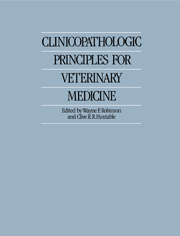Book contents
- Frontmatter
- Contents
- Contributors
- Preface
- Acknowledgements
- 1 The relationship between pathology and medicine
- 2 The immune system
- 3 The hematopoietic system
- 4 Acid–base balance
- 5 The respiratory system
- 6 The cardiovascular system
- 7 The alimentary tract
- 8 The liver and exocrine pancreas
- 9 The urinary system
- 10 The endocrine glands
- 11 The skin
- 12 The skeletal system
- 13 The nervous system
- 14 Muscle
- 15 Metabolic disease
- 16 The reproductive system
- Index
10 - The endocrine glands
Published online by Cambridge University Press: 19 January 2010
- Frontmatter
- Contents
- Contributors
- Preface
- Acknowledgements
- 1 The relationship between pathology and medicine
- 2 The immune system
- 3 The hematopoietic system
- 4 Acid–base balance
- 5 The respiratory system
- 6 The cardiovascular system
- 7 The alimentary tract
- 8 The liver and exocrine pancreas
- 9 The urinary system
- 10 The endocrine glands
- 11 The skin
- 12 The skeletal system
- 13 The nervous system
- 14 Muscle
- 15 Metabolic disease
- 16 The reproductive system
- Index
Summary
Hormone structure, function and regulation
Before embarking on a discussion of the abnormalities affecting endocrine glands, a number of facets of the normal state will be highlighted.
Hormones are chemical messengers. They originate in one part of the body and act on other, often distant, parts. Hormones are selective in their action, influencing only those organs, tissues or cells that are receptive to them.
Although the variety and metabolic consequences of hormones are remarkable, they may be classified into three groups according to the tissues upon which they act. There are those that act directly on non-endocrine target tissues (effector hormones); those that control the synthesis and release of effector hormones (tropic hormones); and those that control the synthesis and release of tropic hormones (releasing hormones).
Hormones may also be classified by their molecular structure into three chemical groups; polypeptides, steroids and amino acid derivatives. This latter classification carries with it some of the fundamental concepts of biochemical mechanisms of hormone action.
Polypeptide hormones
Of the endocrine glands considered in this chapter, the hypothalamus, pituitary, endocrine pancreas and the parafollicular (C cells) of the thyroid produce polypeptide hormones. The hormones within this group vary tremendously in size, from simple molecules to complex polypeptides of up to 190 amino acid residues in length. However, the mechanism of action is basically the same, regardless of the size or amino acid composition of the hormone.
All act by binding to membrane receptors specific for the particular hormone.
- Type
- Chapter
- Information
- Clinicopathologic Principles for Veterinary Medicine , pp. 249 - 274Publisher: Cambridge University PressPrint publication year: 1988



